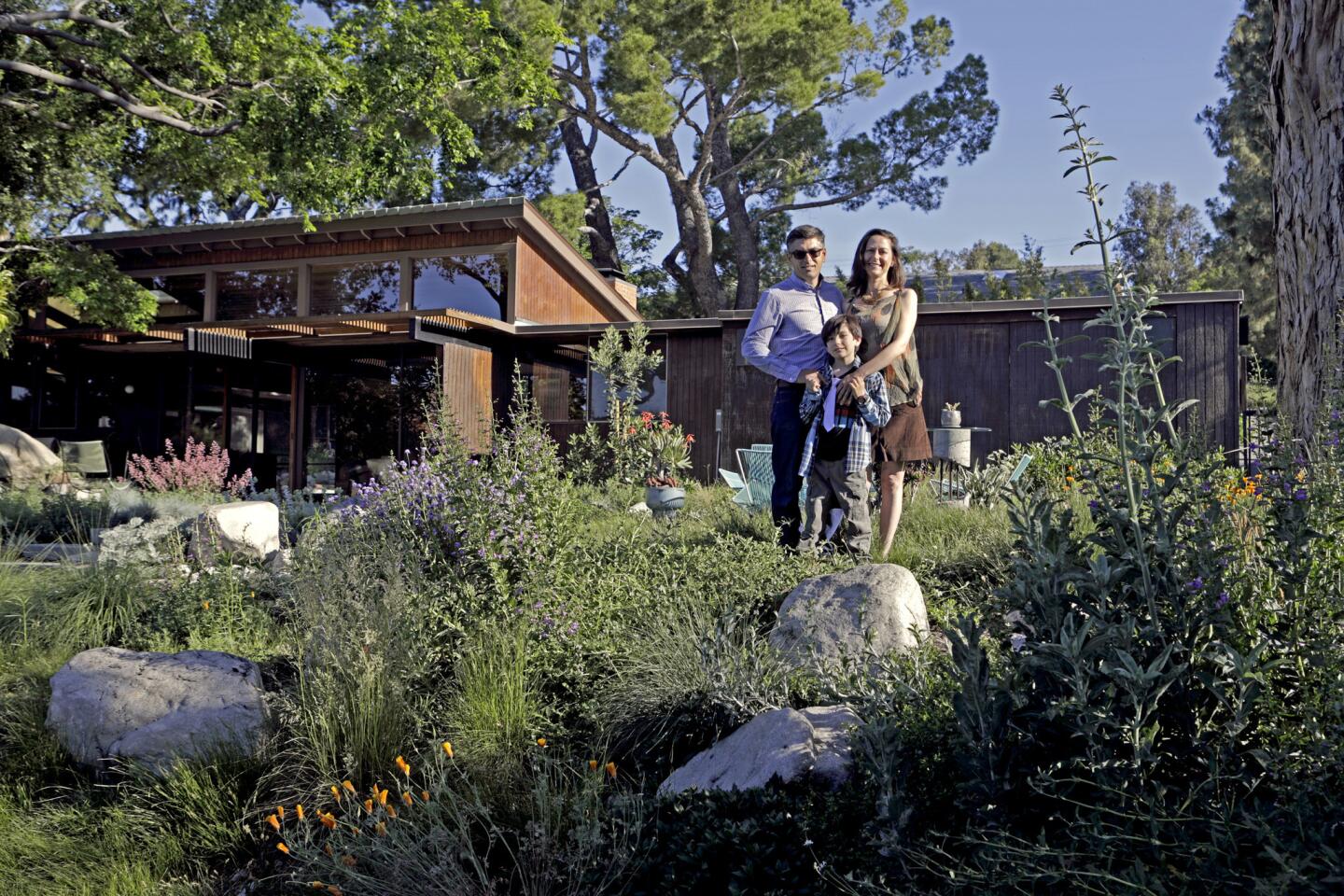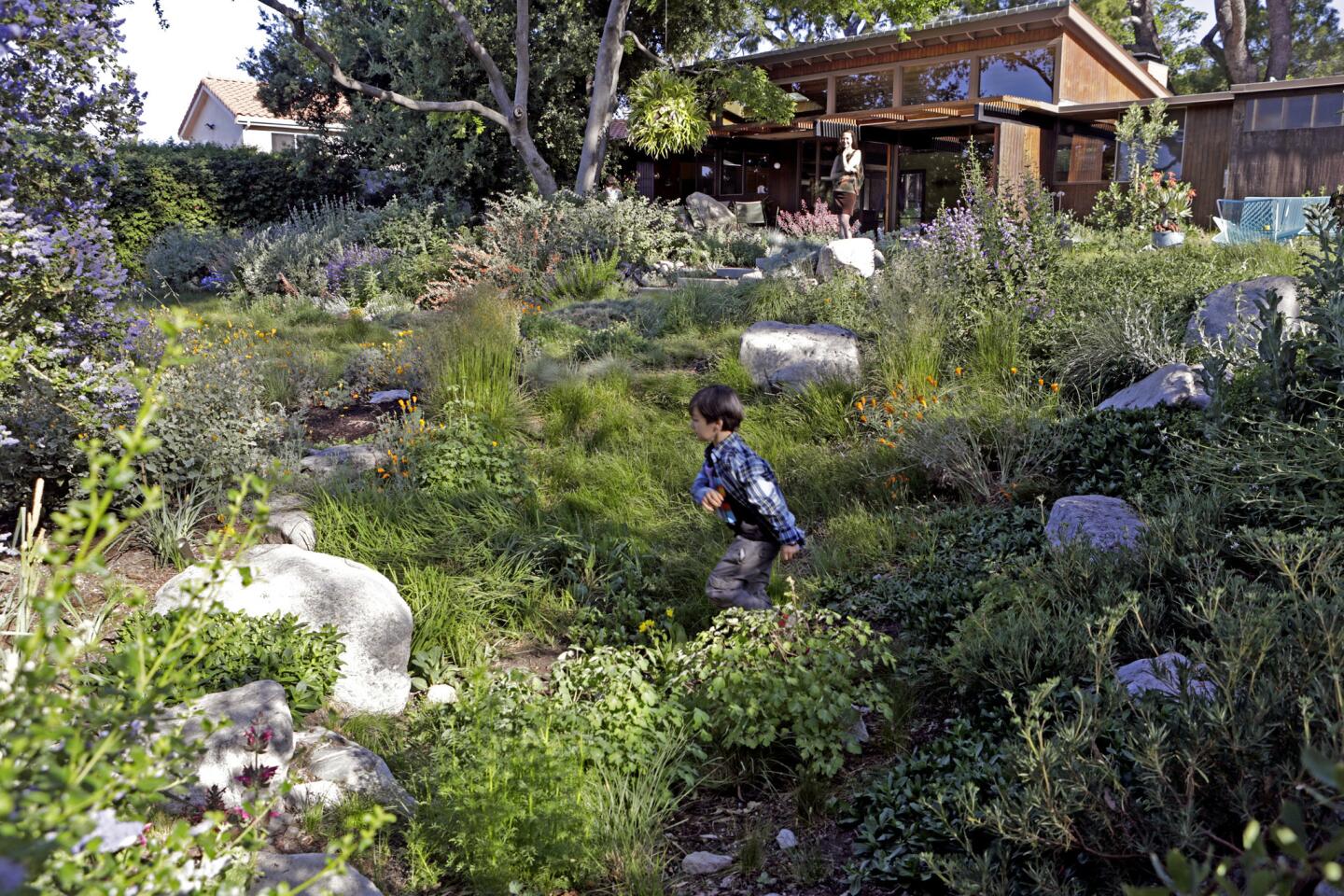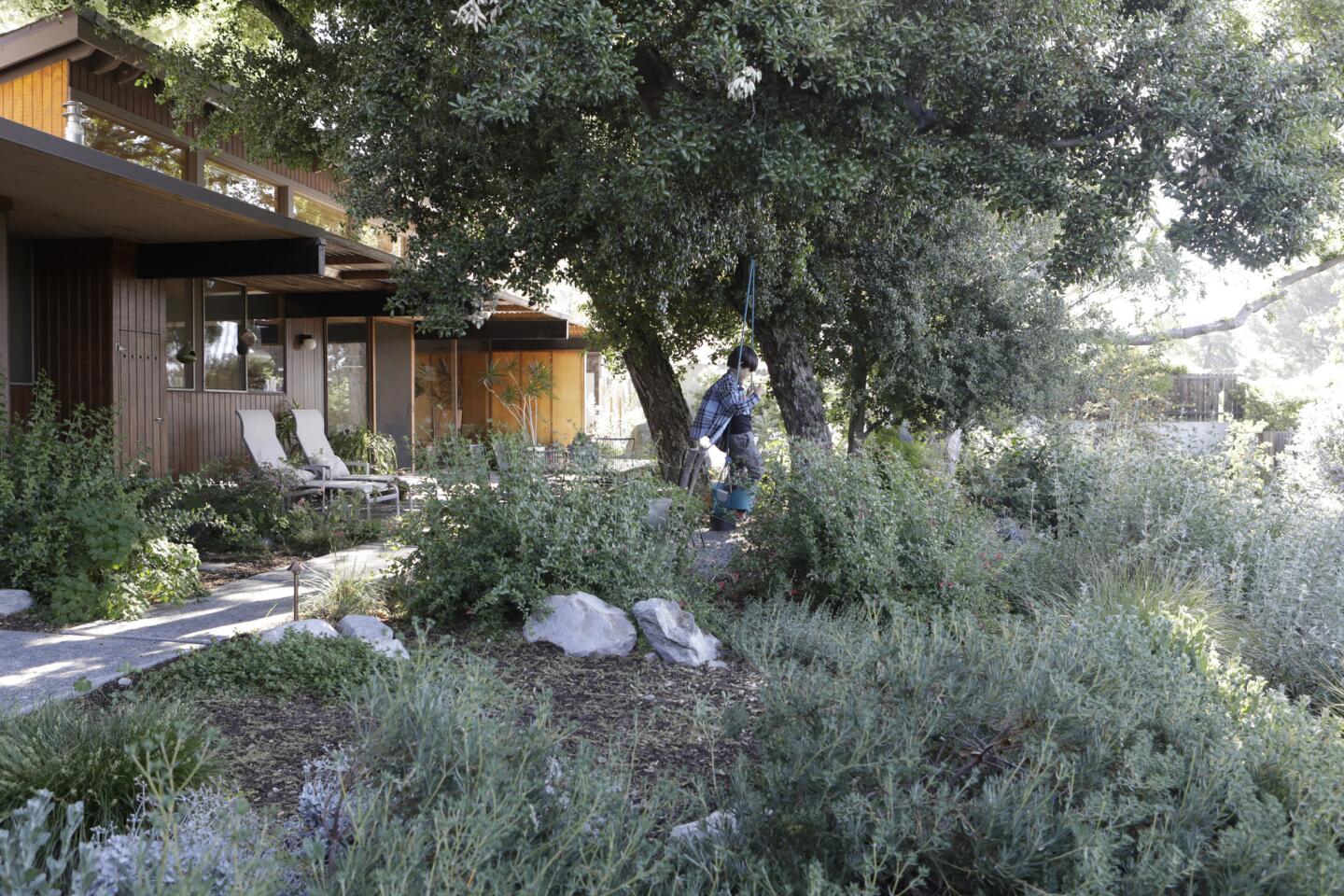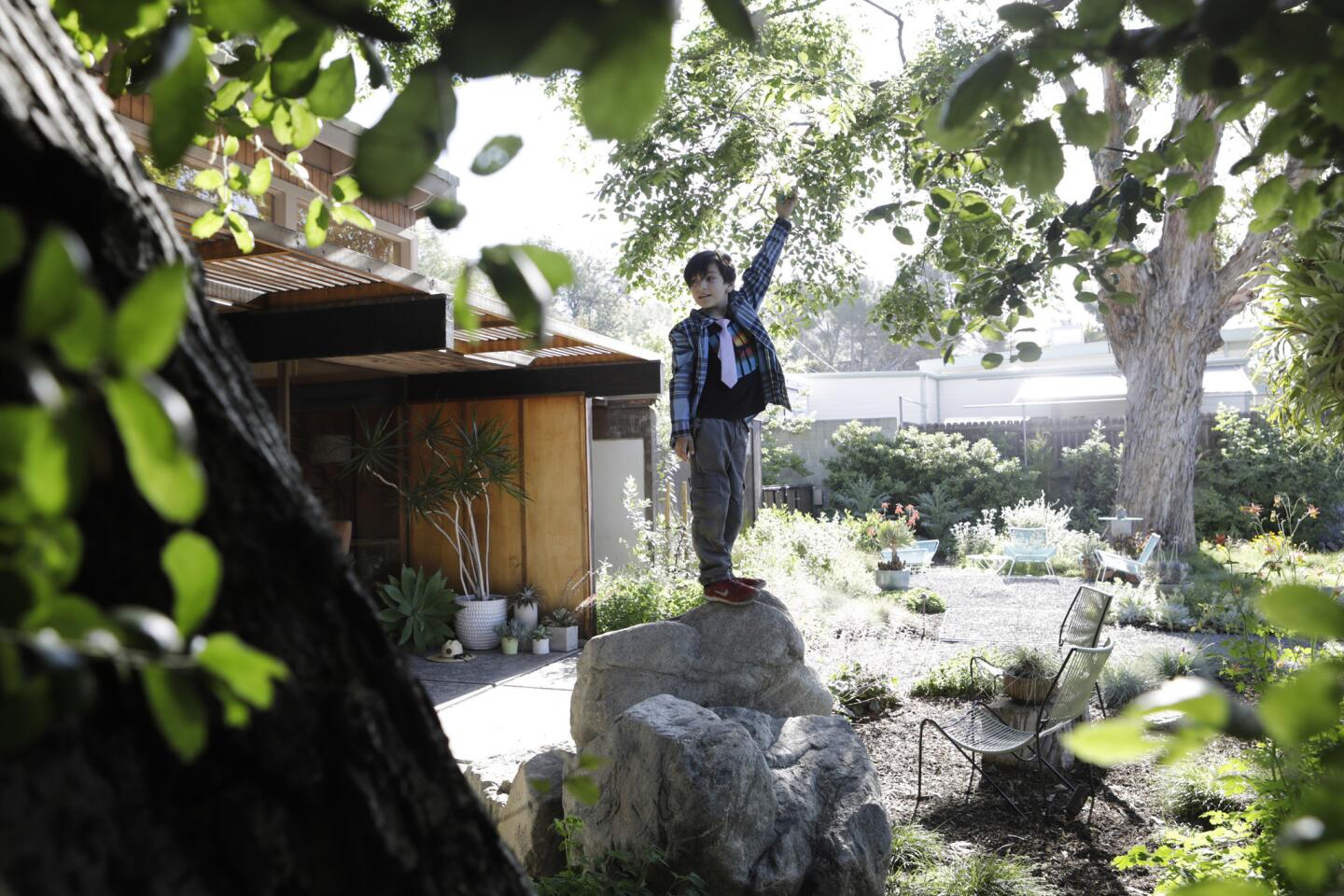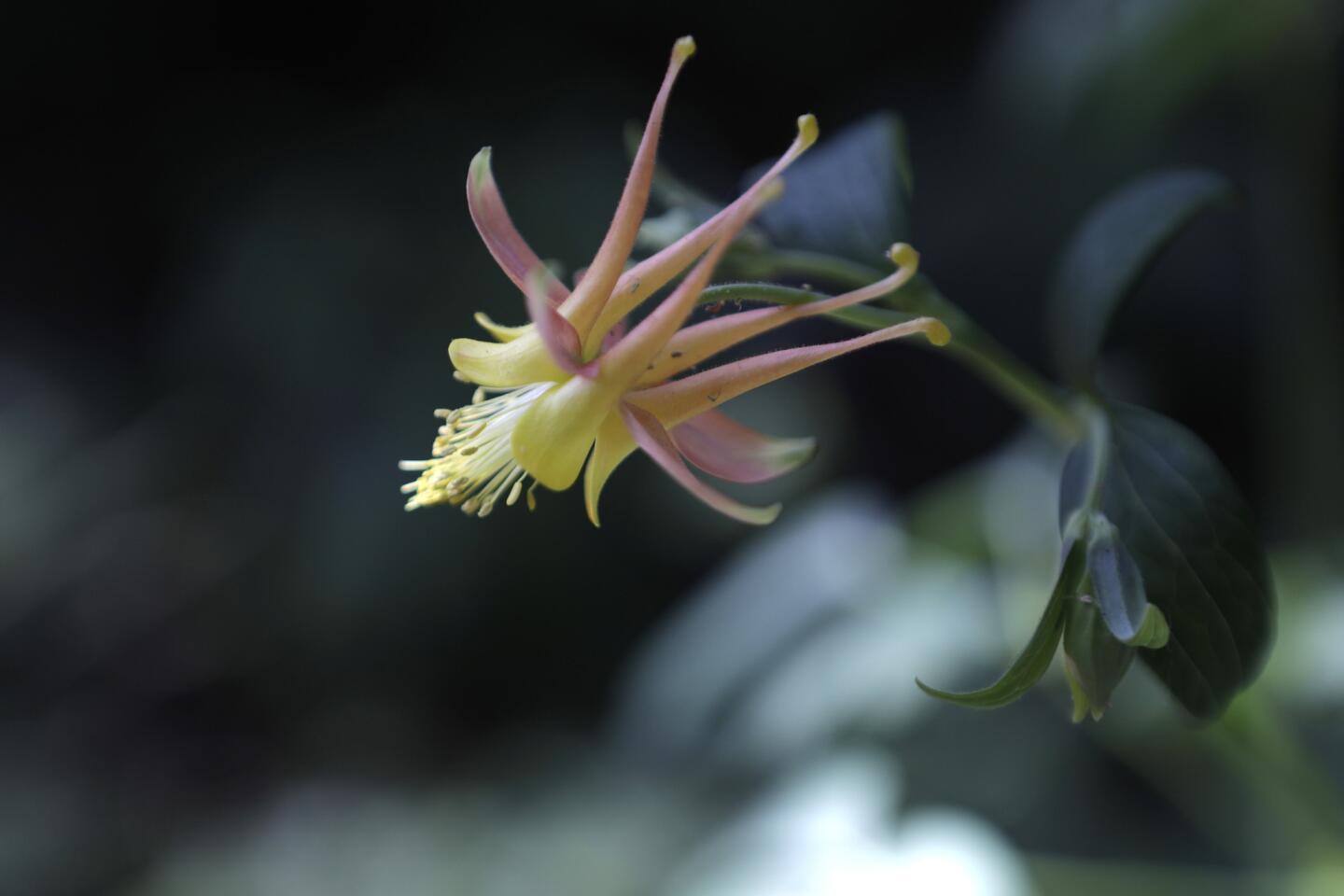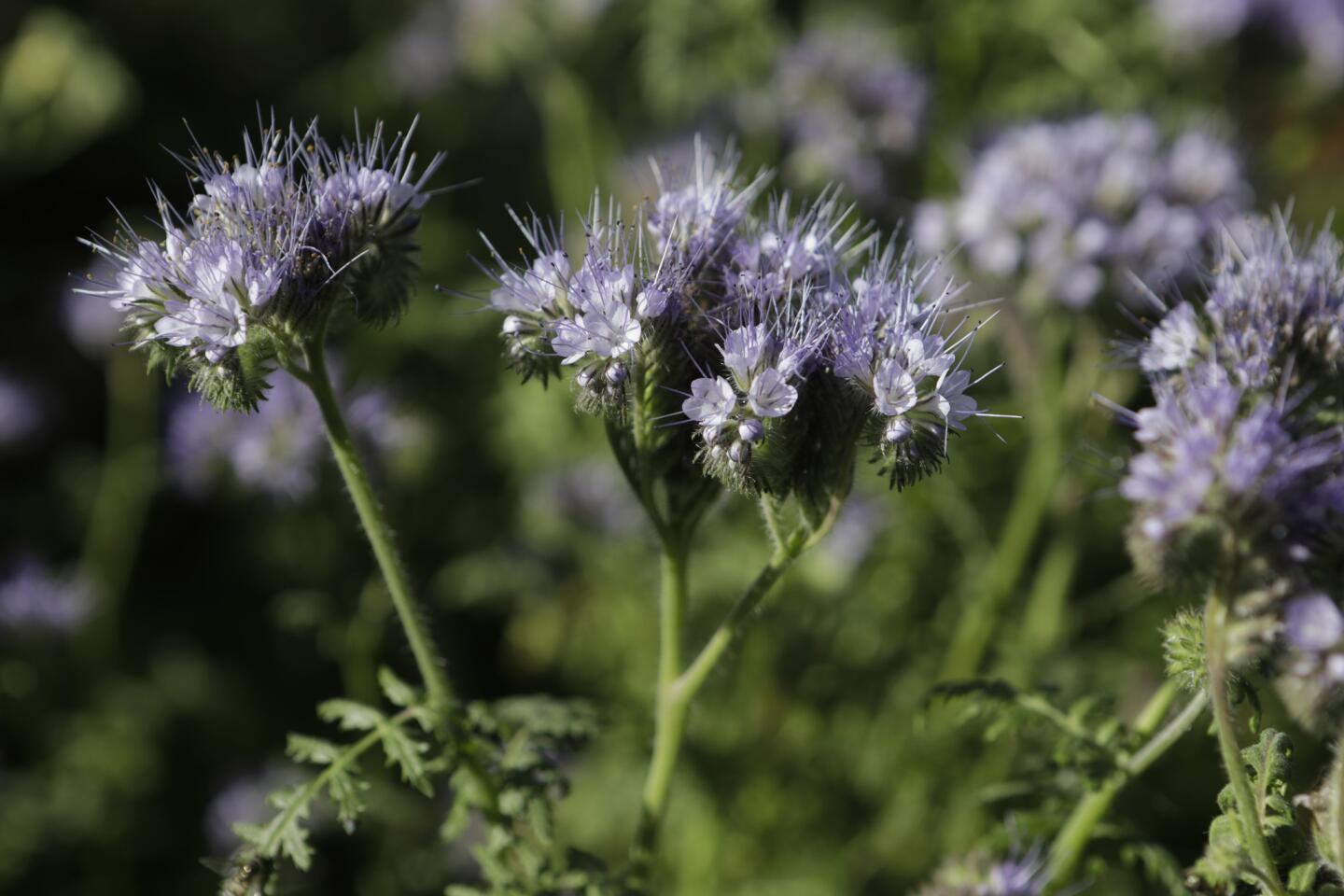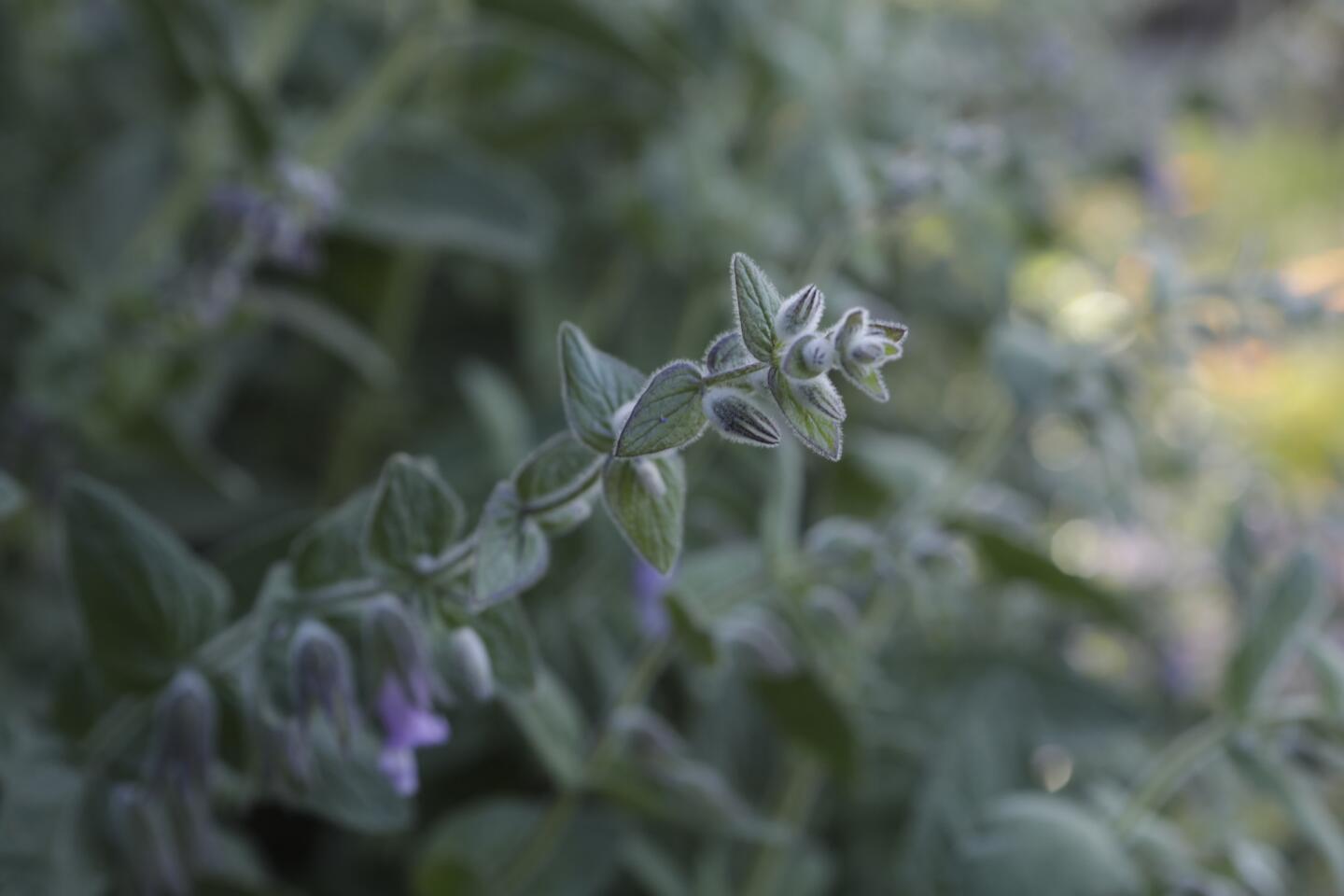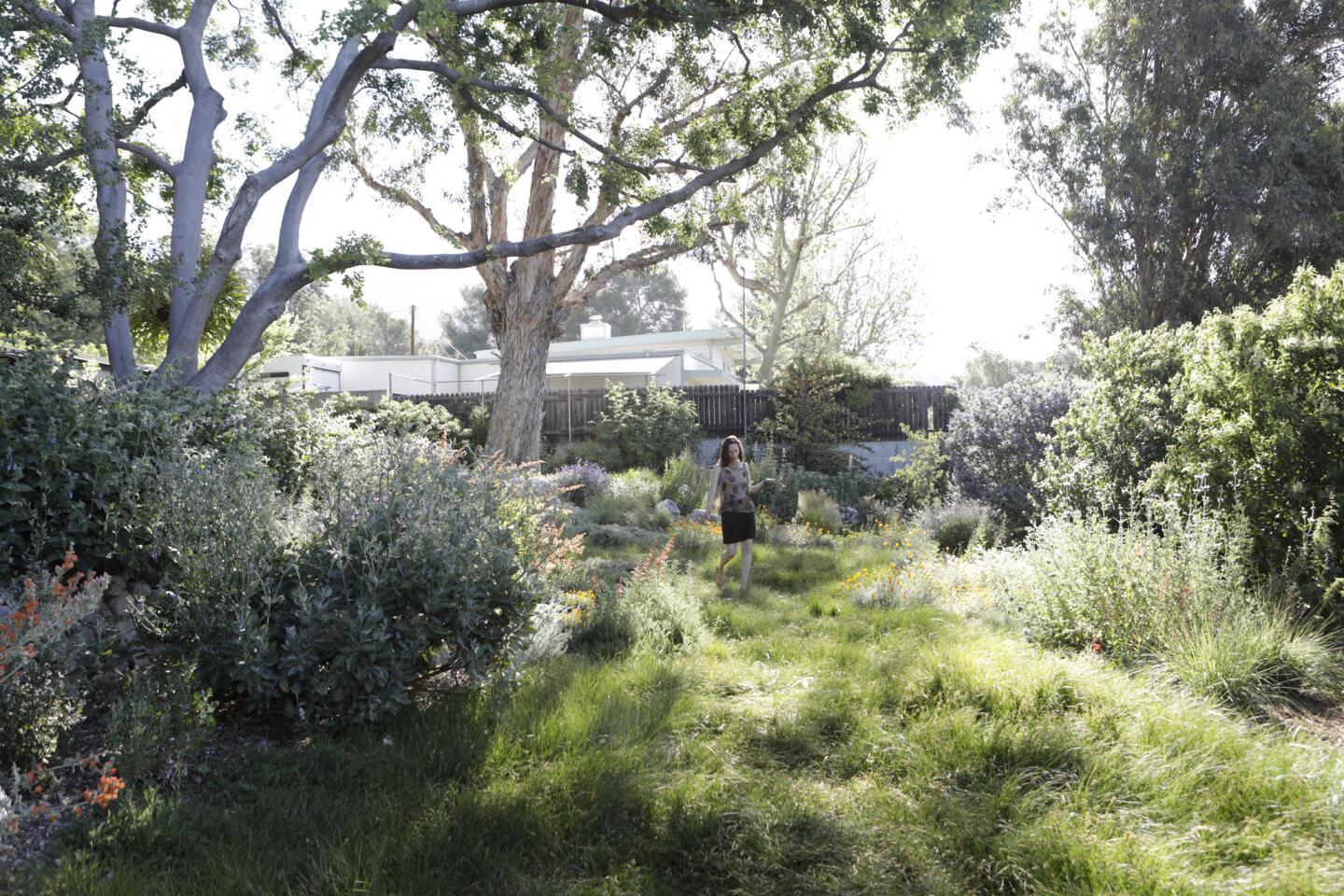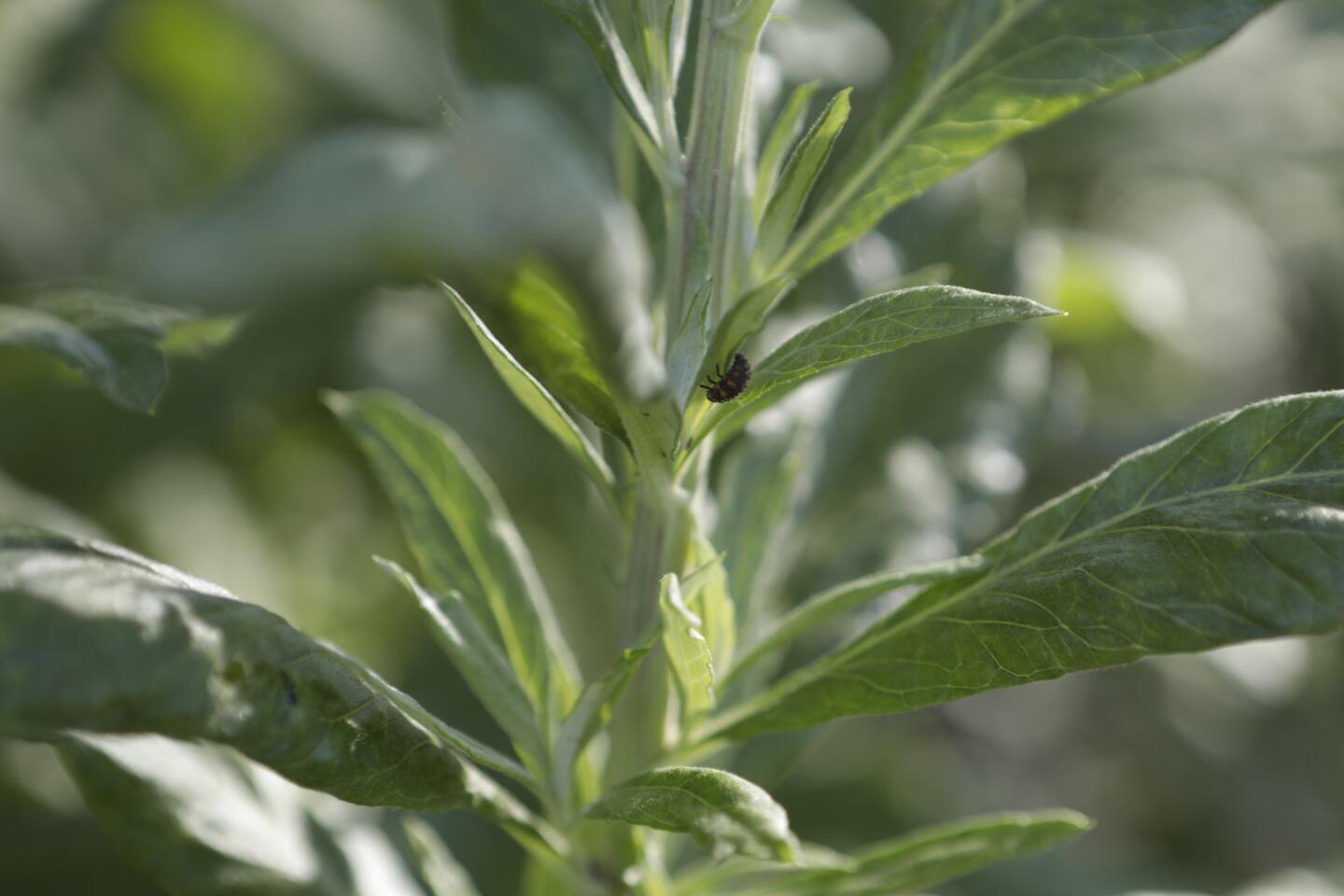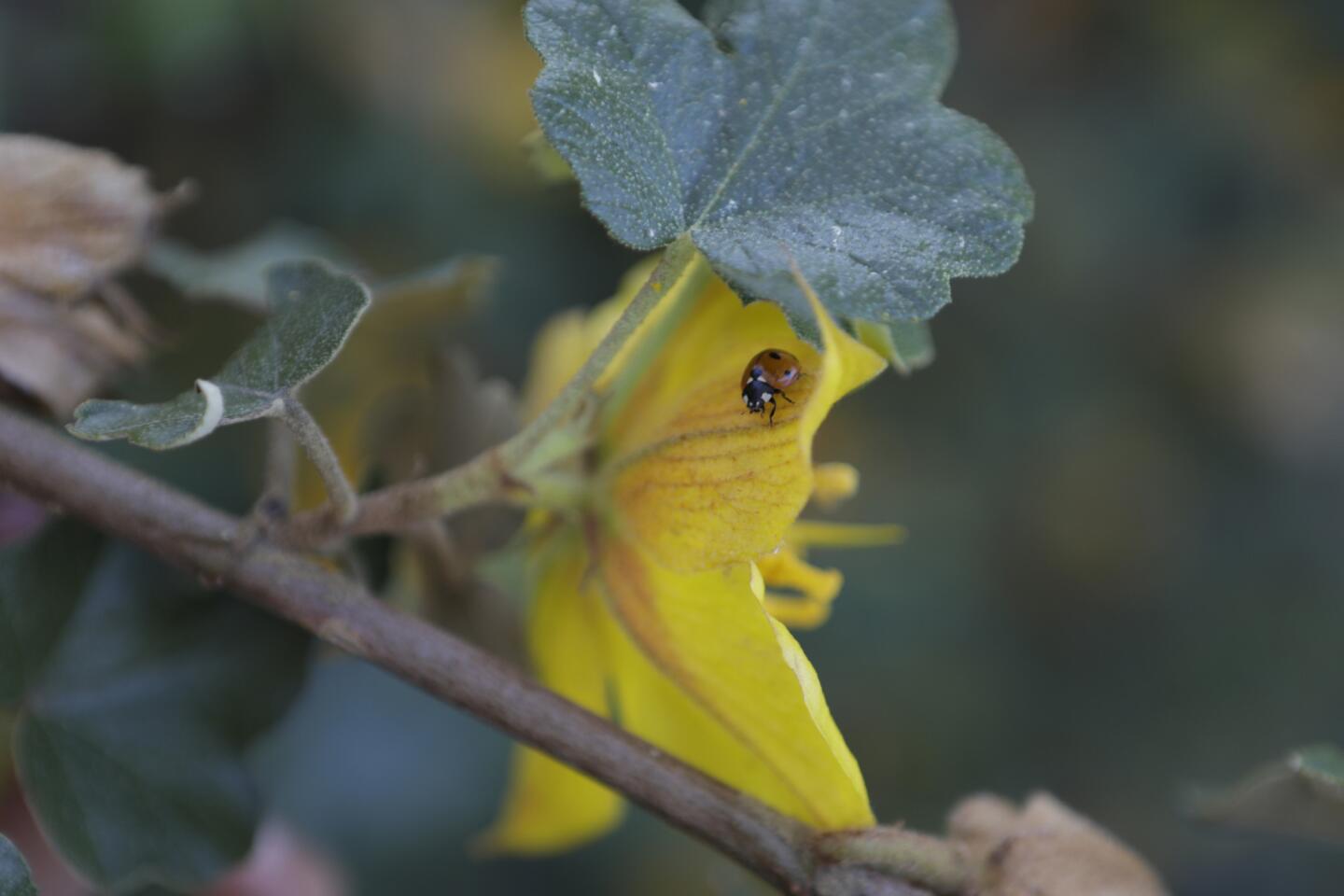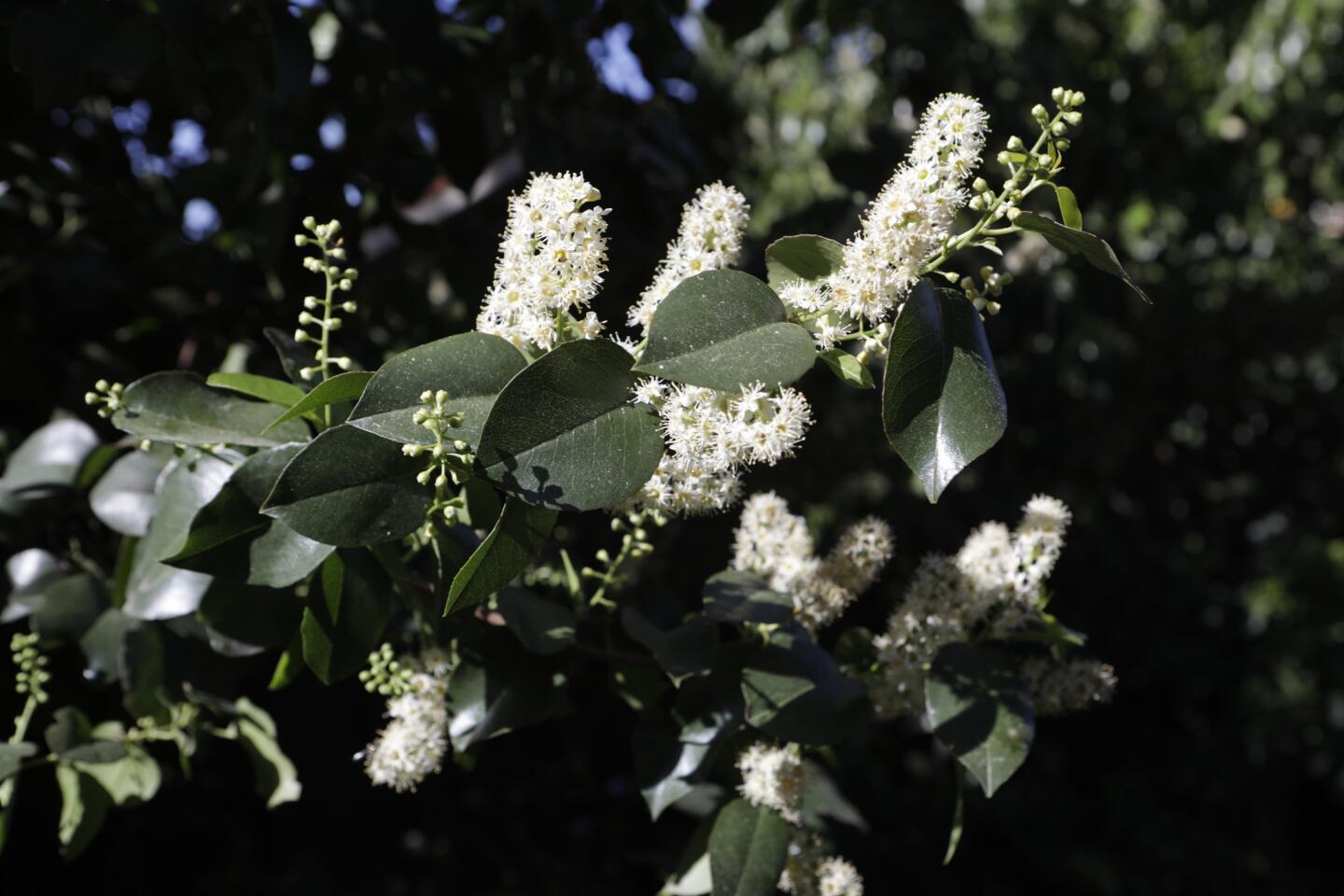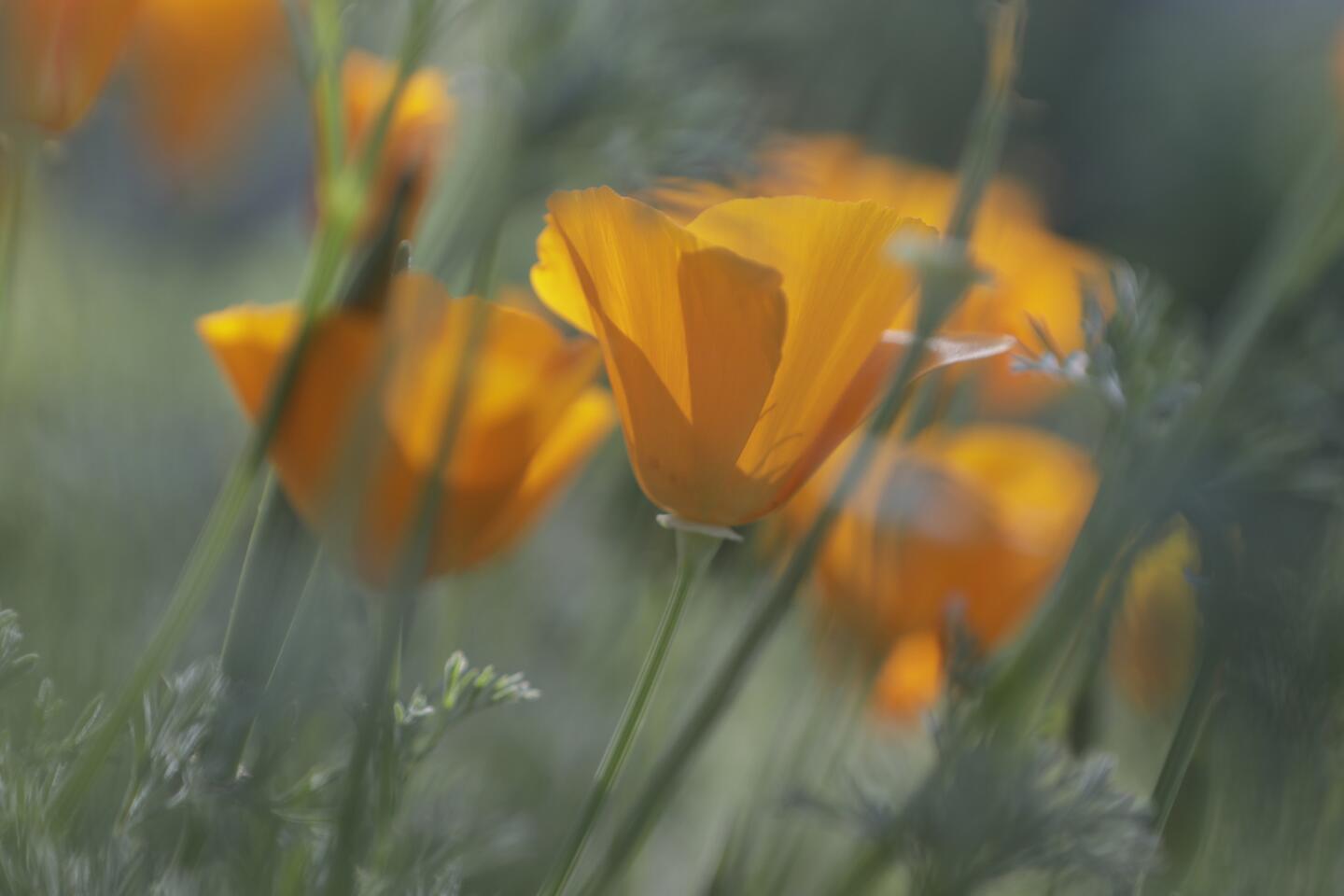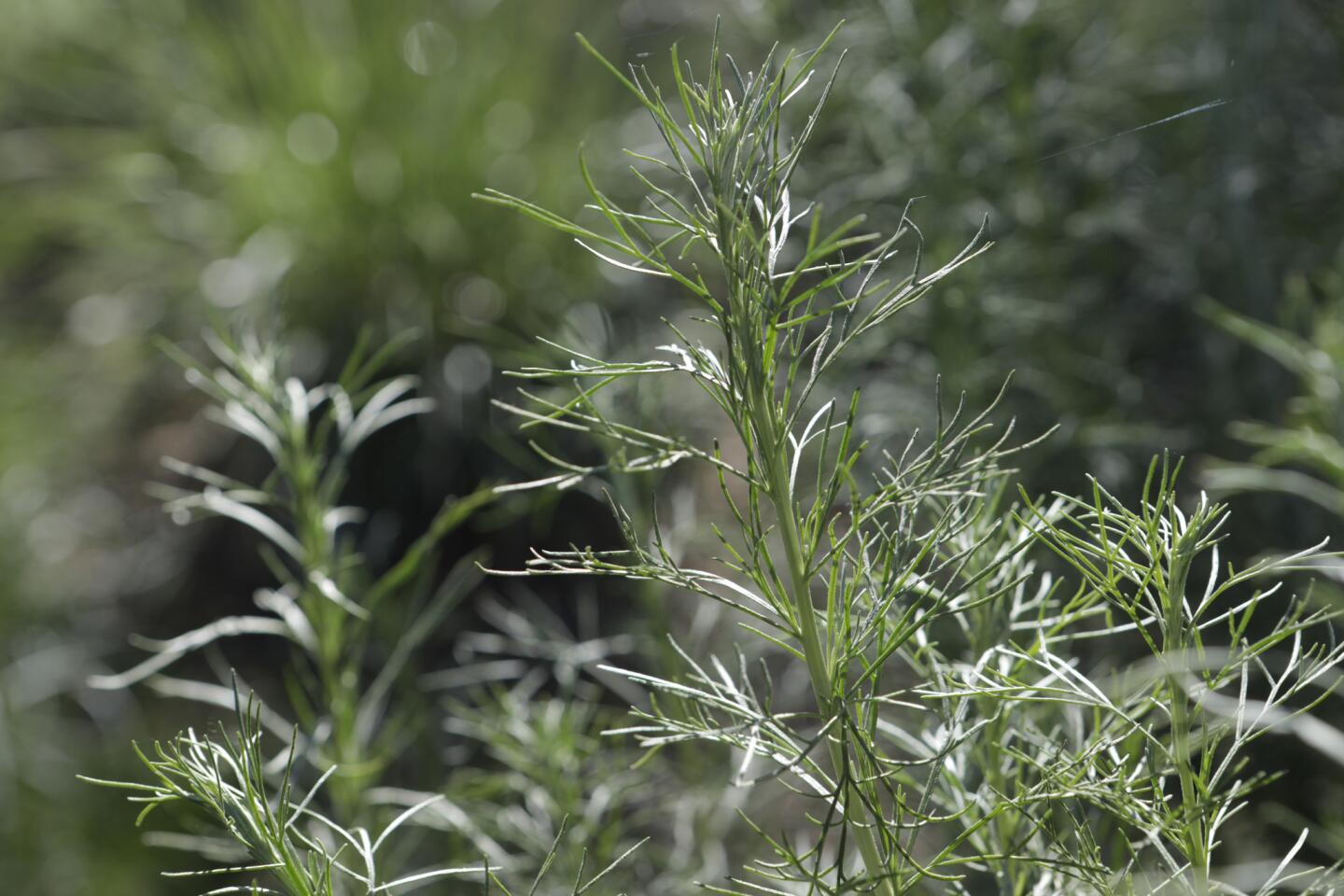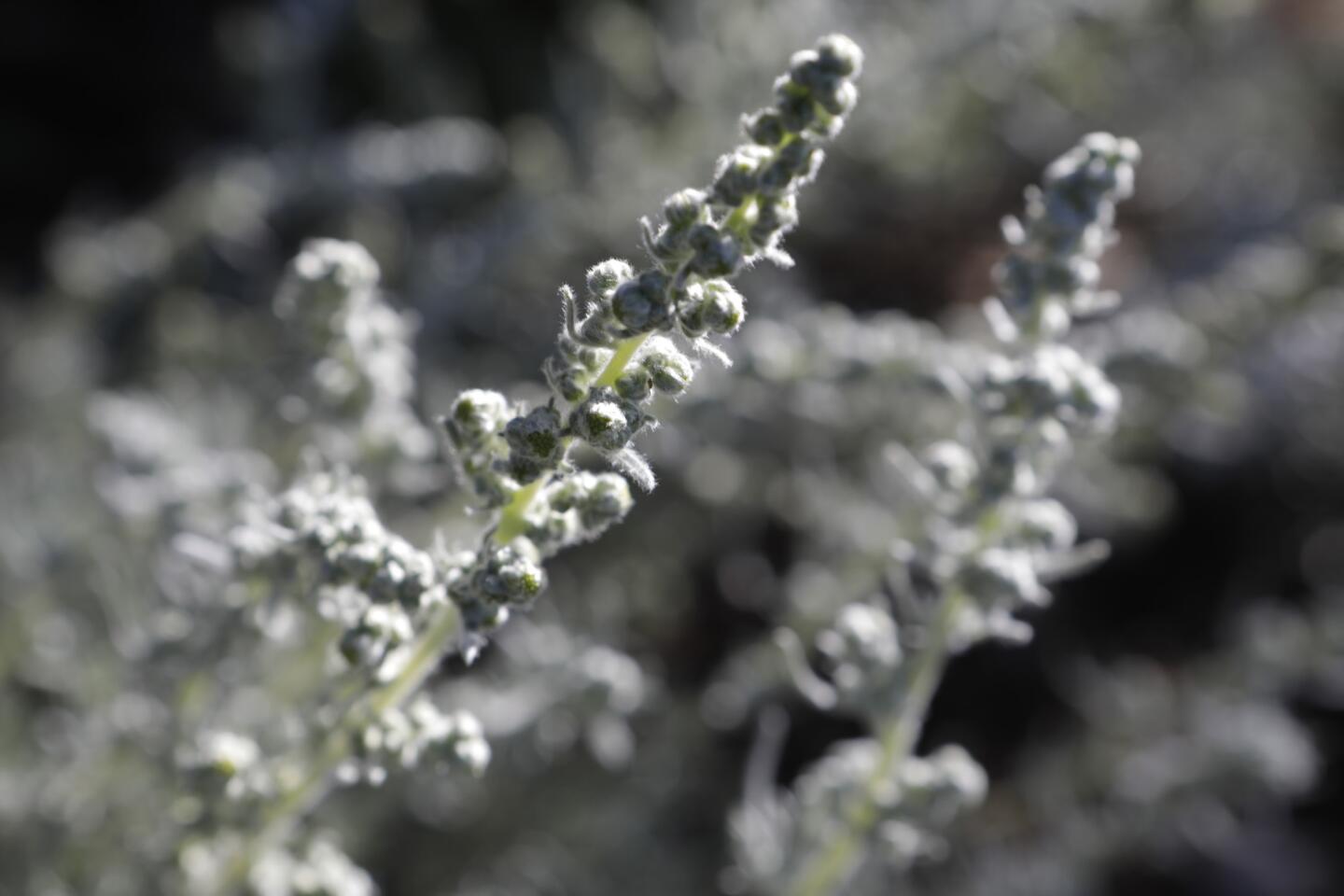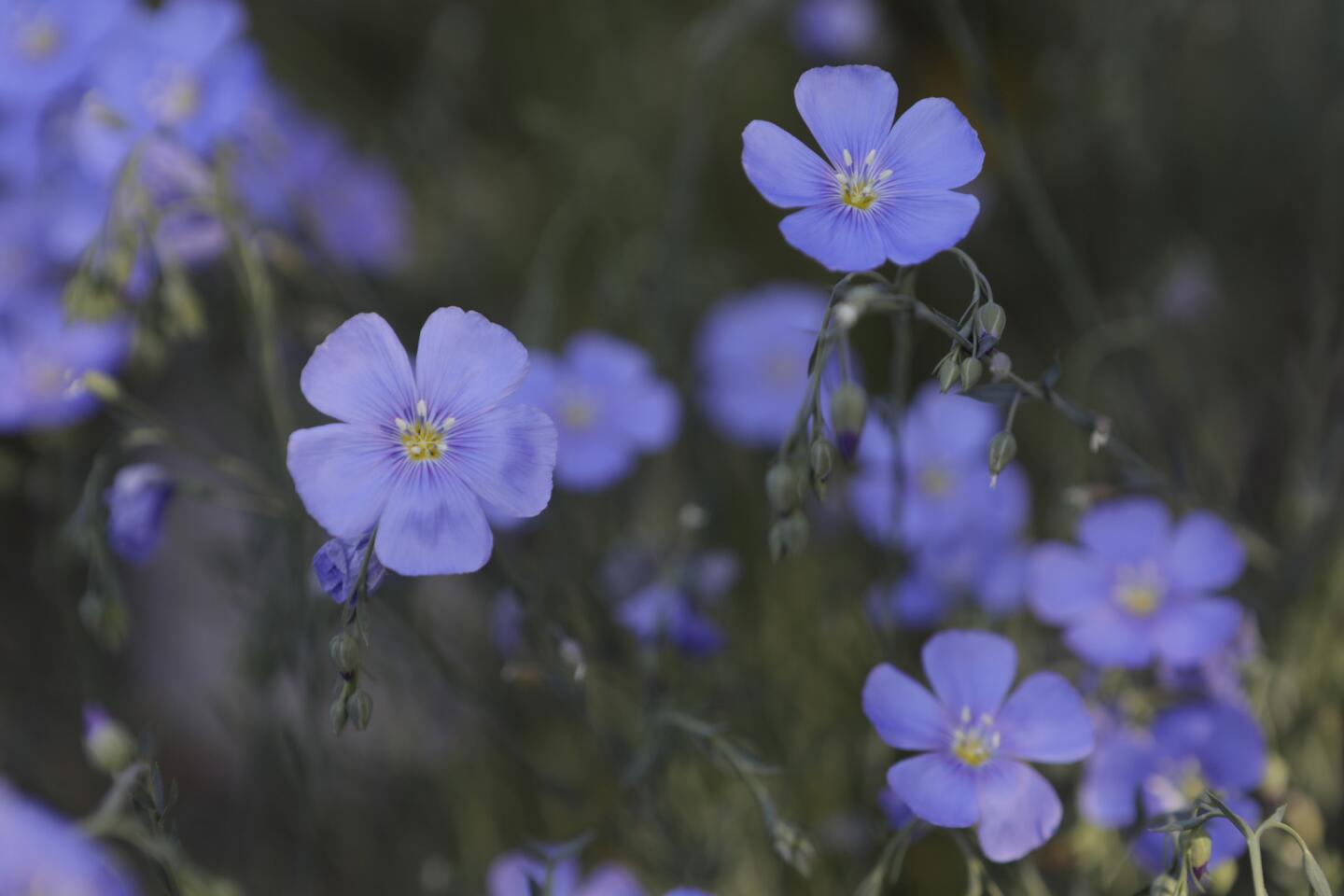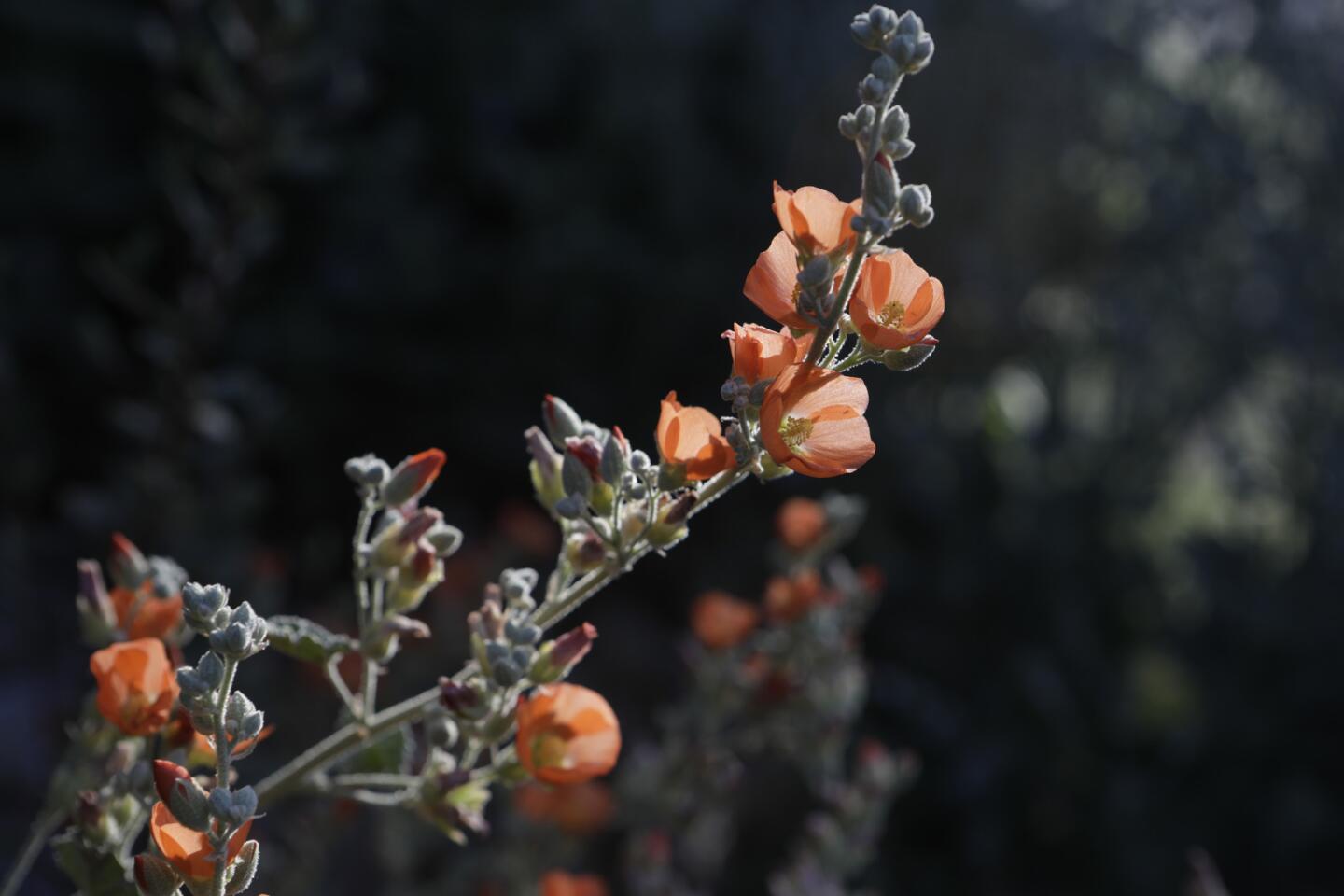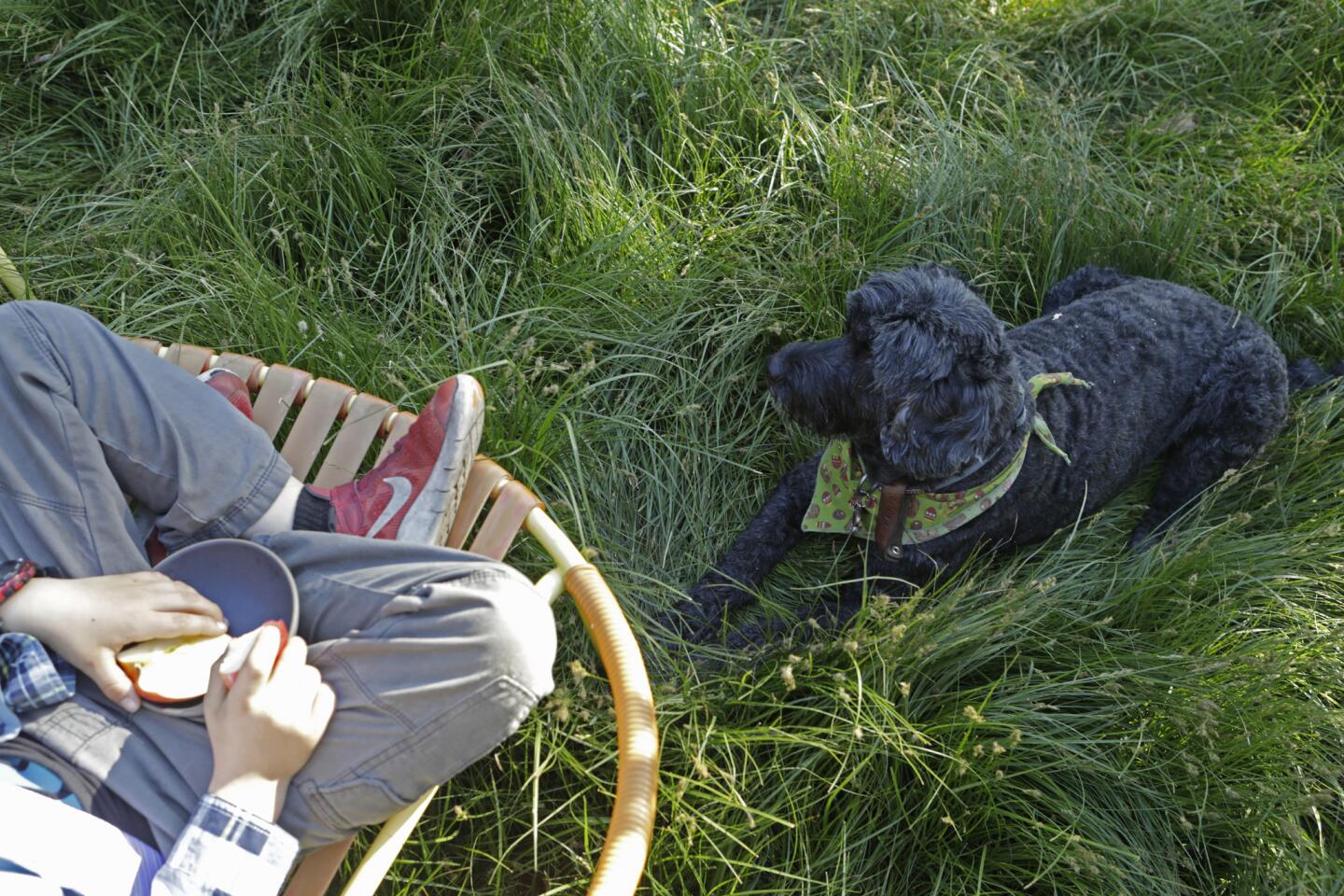This Los Angeles couple is on a mission to save the environment, starting with their own backyard
- Share via
Plant a native; help save Los Angeles. That’s Cassy and Kirk Aoyagi’s mission.
They’re not alone. All over Southern California, gardeners are removing their turf lawns and replacing them with indigenous plantings, prompted by turf removal rebates, the opportunity to combat climate change and, as Kirk says, “just doing the right thing.”
“We can save the world by planting natives,” Cassy said as she offered a walk through the couple’s lush, natives-filled backyard in Tujunga. As you watch the birds and butterflies descend upon the garden’s native flora — a profusion of lilacs, sage, poppies and fragrant artemisia you might find while hiking in Griffith Park — you find yourself nodding in agreement.
For this landscape is more than just a garden, it’s a thriving natural habitat.
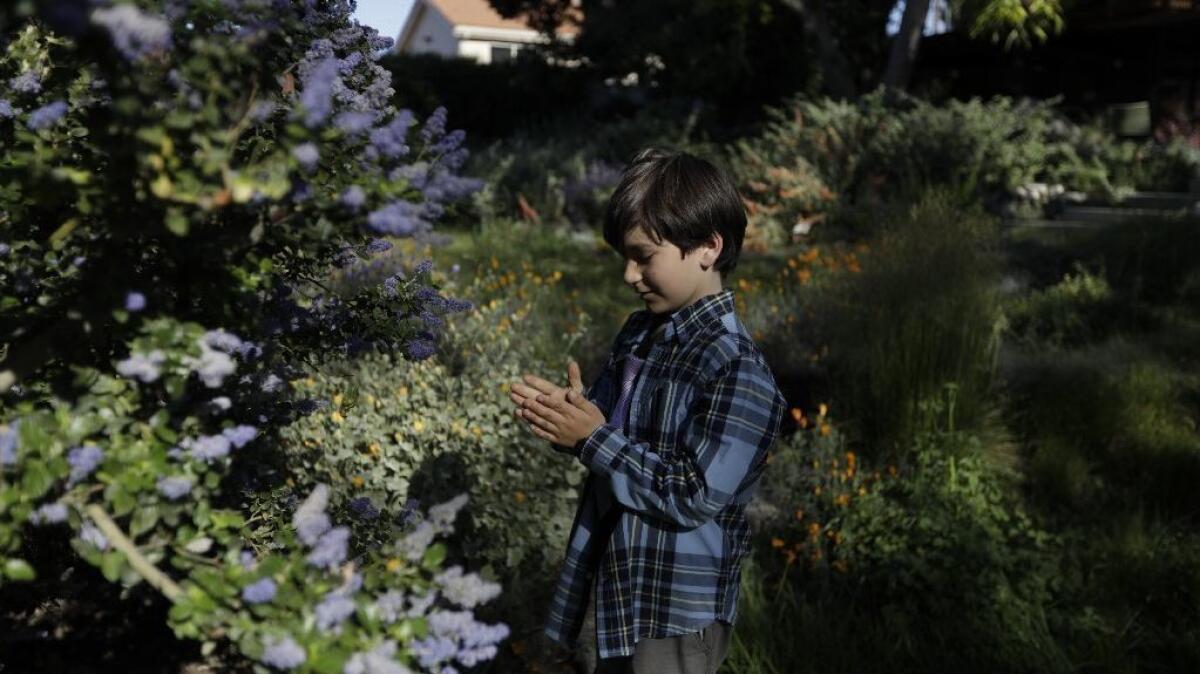
For more than 20 years, the FormLA Landscaping designers have worked to improve the landscape of Los Angeles by replacing more than 200,000 square feet of turf with authentic, adaptable California native plants.
“Cassy and Kirk exemplify the type of sustainable business model that is so common here in Los Angeles,” said Dominique Hargreaves, deputy chief sustainability officer for Mayor Eric Garcetti’s office. “One that is guided by the belief that environmental stewardship and economic prosperity go hand in hand.”
In 2010, when the couple spotted a 1953 post-and-beam house in Tujunga for sale, they jumped at the chance to purchase a property where they could practice their mission. The home had more than just great Midcentury Modern architecture — it featured a bare backyard of dirt, boulders and trees. (In a bit of Hollywood trivia, the home’s original owner was artist Lew Keller, who directed episodes of “Rocky and His Friends” and “George of the Jungle” TV shows).
“We wanted to show people that they can use all native plants and have all of the uses and beauty that anyone could want of any garden,” Cassy said. “We can get so much more out of using these plants in strategic ways.”
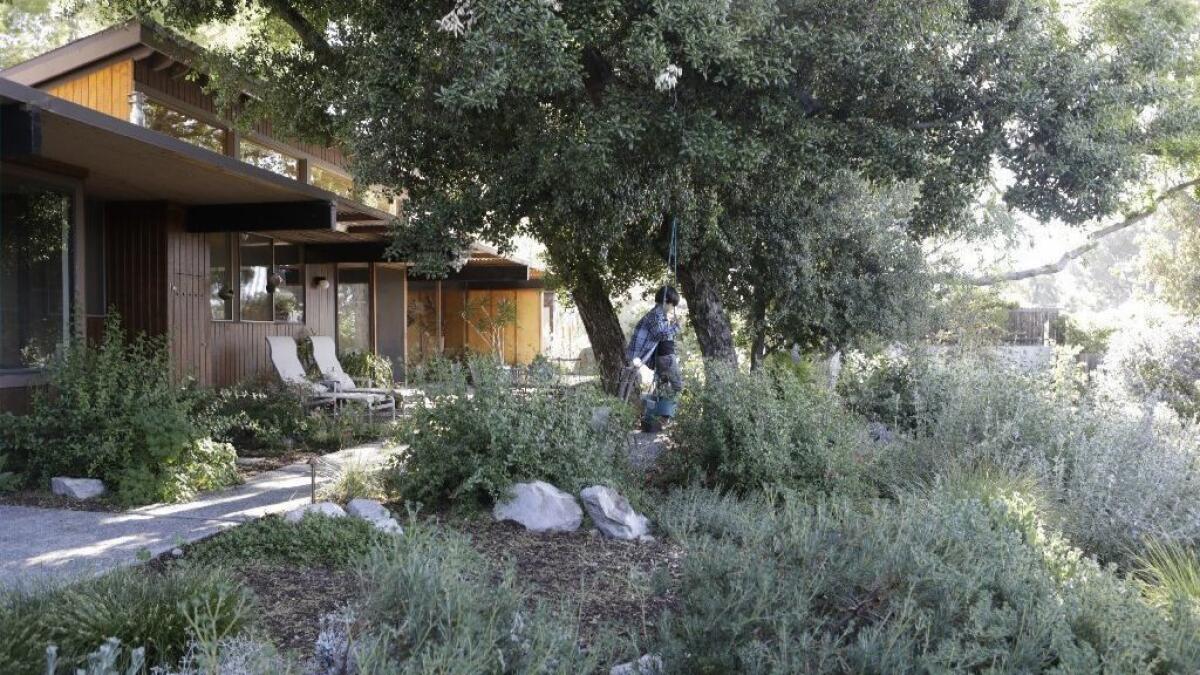
Soon after buying the home, the couple tackled the yard by following their own advice: They covered the landscape with 12 inches of Cal Blend Soils mulch, then waited and watched as their son, Yoshi, who is now 8, took over the yard.
“We watched the things that he gravitated toward,” Cassy said. “Running loops, riding his bikes on dirt moguls and climbing boulders. We really were tuning in to how we could preserve each of those functions and still develop the yard so that it made us feel ensconced.”
When a massive Italian stone pine tree fell over four years later, they decided it was time to address the newly naked and exposed yard.
The first plantings were California lilacs (Ceanothus), Catalina cherries (Prunus ilicifolia) and Nevin’s Barberry (Berberis nevinii), selected to create a privacy hedge along the back fence.
Broken concrete paths and hardscape were replaced and restored with an exposed aggregate finish to complement the home’s Midcentury Modern aesthetic. Once the paths were done, a flat patio area was added behind the garage to provide a “grown-up” seating area and place for entertaining.
“We really wanted to make sure that there is function that supports lifestyle,” Cassy explained. “That really dictates design. You need that grown-up space to hang out. We all love plants, but there needs to be structure.”
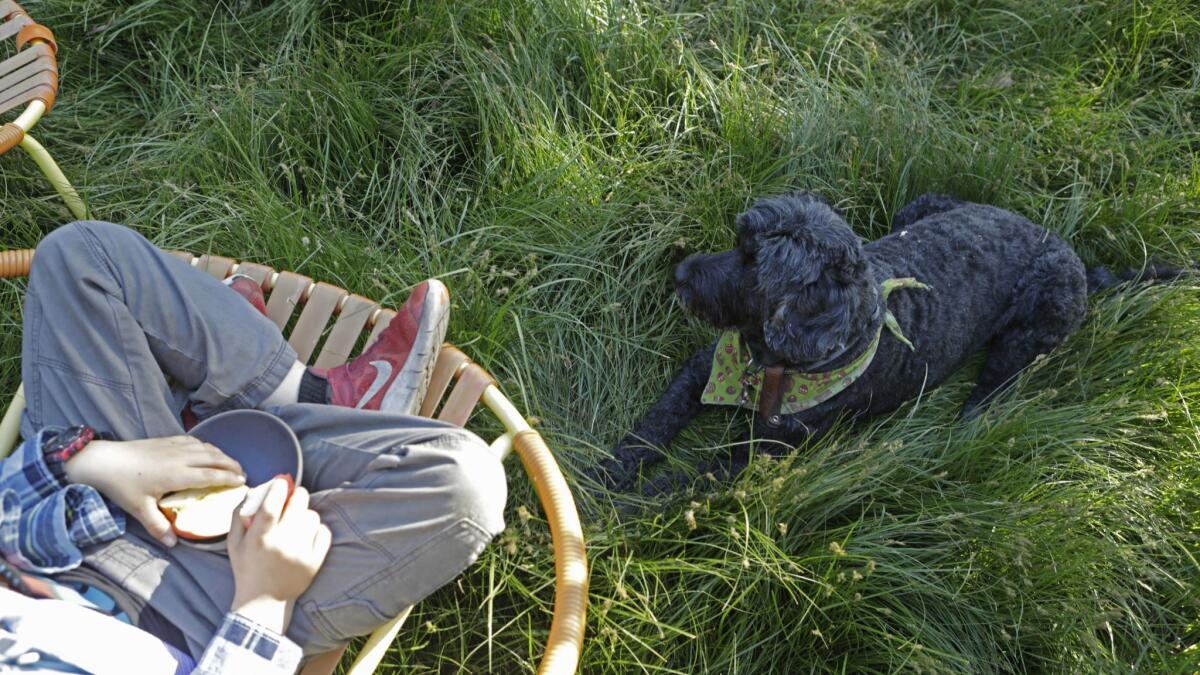
When it came time to choose a plant palette, the couple were understandably overwhelmed.
“We spitballed a huge list of 70 different native plants,” Kirk said. “I basically asked, ‘What is everything you would want?’ Then we took the list of plants and saw what was available. We figured out the quantities and what would work to create a vernal pool.”
They narrowed the list by dividing the plants into three categories: hyper-local plants to save water, chaparral plants to fight erosion, and medicinal/edible varieties like California coffeeberry and sagebrush for self-sufficiency.
As soon as they decided on the plants, the couple installed a meadow on the west side of the yard by planting plugs of carex pansa, a lawn substitute that mimics the look of traditional turf but requires much less water and maintenance.
On either side of the meadow, the couple planted colorful bunches of natives — yellow Flannel Bush (Fremontadendron), crimson Western Columbine, (Aquilegia formosa), delicate blue Lacy Phacelia (Phacelia tanacetifolia), four different types of Artemisia, bright pink Wendy Coral Bells, orange Desert Globemallow (Sphaeralcea ambigua) and Lewis Flax (Linumlewisii) to give the landscape a pastoral feel. The majority of the plants came from the Theodore Payne Foundation in Sunland and El Nativo Growers, a wholesale company in Azusa.
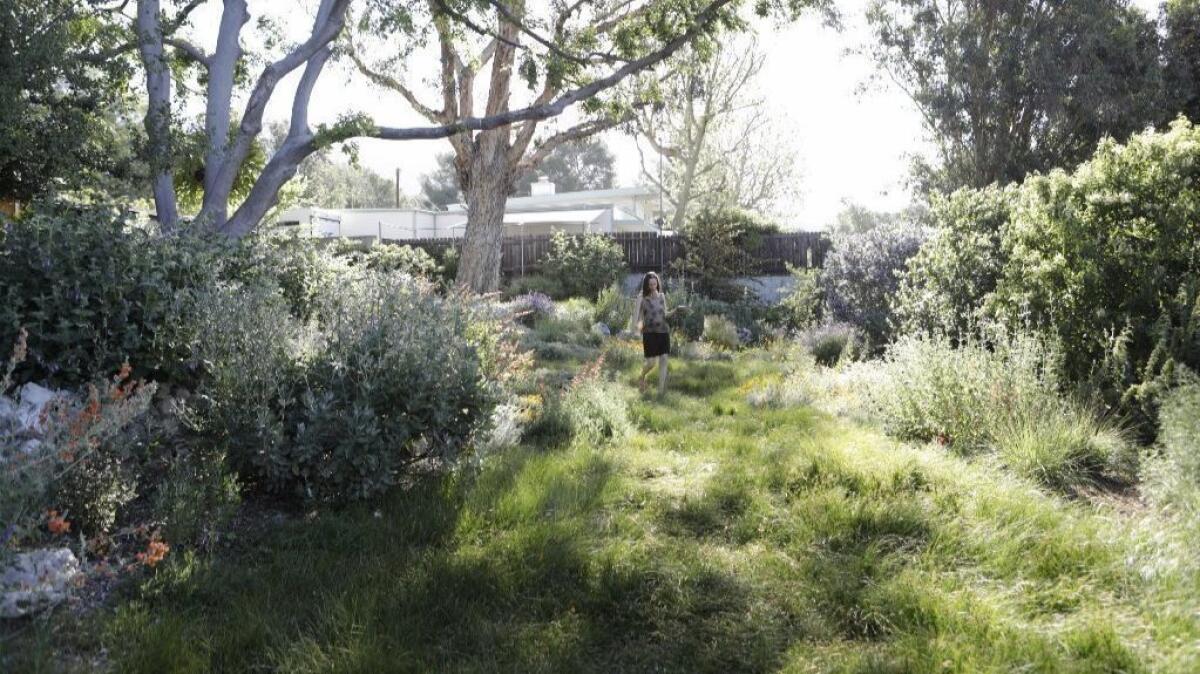
A vernal pool, or seasonal wetland, installed in a natural depression on the southeastern corner of the lot, absorbs water runoff from the home’s steep driveway, roof and the neighbor’s hardscape. It also allowed the couple to play with wetter plant material such as California Hair Grass (Deschampsia cespitosa) at the top of the pool, Seep Monkey Flower (Mimulus guttatus) in the center of the pool and California buckwheat.
One of the garden’s most distinctive touches is the use of existing boulders, which have been strategically placed throughout the yard like massive stepping stones. “When we saw how the boulders were working, we made sure that we moved them to areas where we like to hang out so that we can be a part of that experience,” Cassy said.
Now, Yoshi can rock-hop around the vernal pool, leap onto the meadow and play fetch with their dog, Dara, on the Carex pansa sedge.
After the natives were planted, the food web took off, the Aoyagis say. Hawks, possums, western fence lizards and crows are now regular visitors to the yard, along with bees, ladybugs, caterpillars and monarch butterflies.
Maintaining a balance between nature and the concrete jungle of Los Angeles can be tricky, but the Aoyagis are committed to creating valuable green space at home and at large for anyone “walking down the street in a bad mood to kids who need the ability to romp a bit.”
And despite being native purists, the couple are open to accommodating clients who are sentimental about certain non-natives and want to add them to the mix.
“Most people, at this point, come to us knowing our approach,” Cassy said. “They are sold on our philosophy long before they contact us. If we lose business in a competitive pitch process due to our commitment to sustainability, we don’t lose sleep.”
“Everyone deserves to find the right fit,” she continued. “Landscaping affects our health, our mood and our stress level. Humans thrive when we are connected to nature and place. Our authentic beauty can save us in so many ways.”
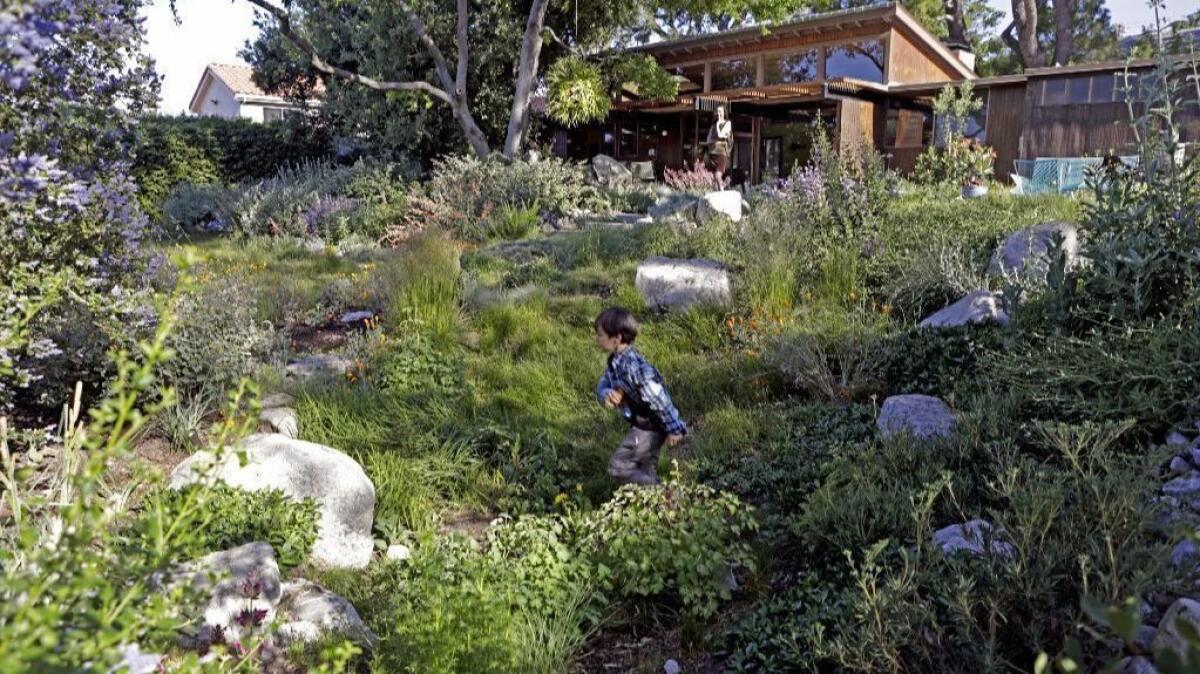
The FormLA duo offers tips on matching landscape to architecture:
The hardest part of a landscape renovation is often envisioning what you want. Architecture, interior design and even fashion tastes can be effective starting points in identifying the native plants that will give you joy. For example:
If you like Modern architecture common in Venice, try:
Blooms: Yucca whipplei and Juncus patens
Lawn: Red fescue meadow
Tree: Palo Verde
If you like Spanish/Mediterranean styles of Pasadena and midcity, try:
Blooms: Brittlebush and White Sage
Lawn: Carex pansa mowed or meadow
Tree: Catalina Ironwood
If you have a bungalow, cottage or Craftsman, try:
Blooms: Alumroot, Ceanothus
Lawn: Yarrow mowed or meadow
Tree: Western Redbud
If you like the traditional architecture of Hancock and Leimert Parks, try:
Blooms: Rosa Californica and Pacific Coast Iris
Lawn: Red fescue meadow
Tree: Desert Willow
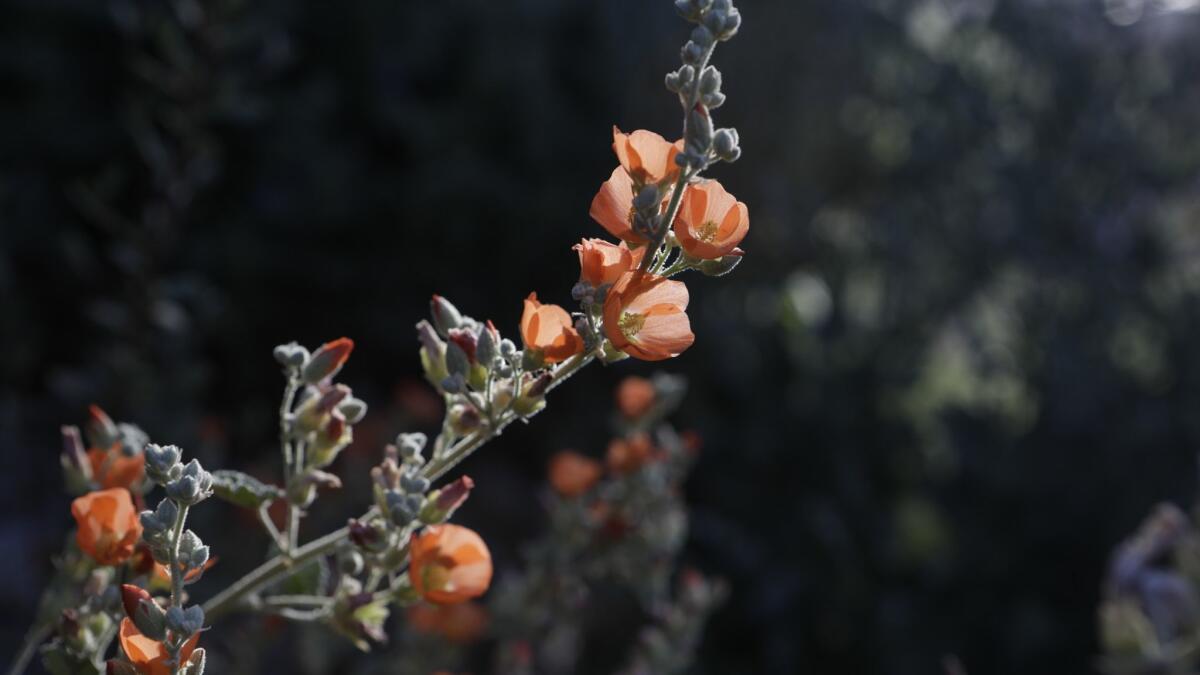
More to Read
Sign up for The Wild
We’ll help you find the best places to hike, bike and run, as well as the perfect silent spots for meditation and yoga.
You may occasionally receive promotional content from the Los Angeles Times.
